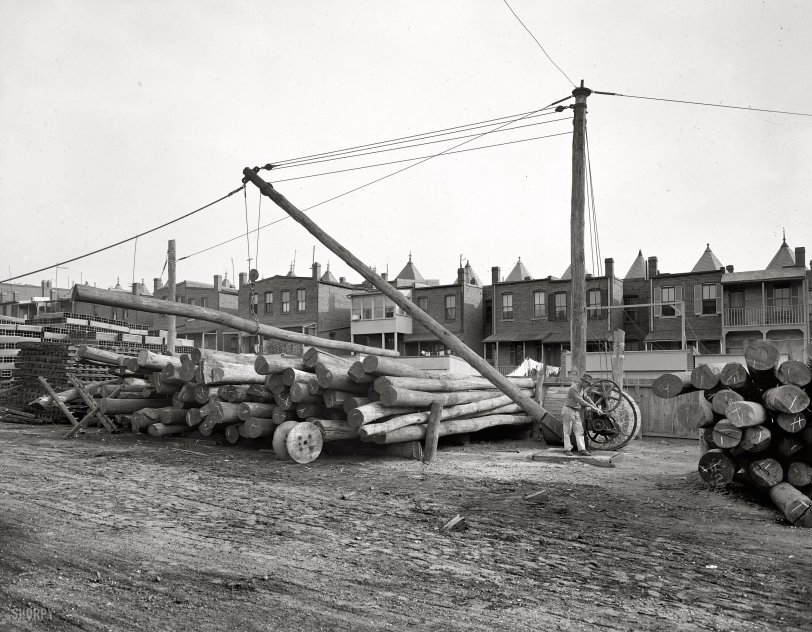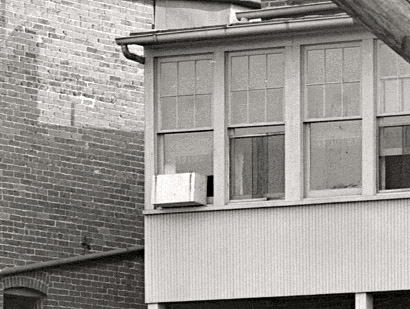


Framed or unframed, desk size to sofa size, printed by us in Arizona and Alabama since 2007. Explore now.
Shorpy is funded by you. Patreon contributors get an ad-free experience.
Learn more.

- Baldwin 62303
- Baldwin VO-1000
- Cold
- No expense spared
- Tough Guys
- Lost in Toyland
- And without gloves
- If I were a blindfolded time traveler
- Smoke Consumer Also Cooks
- Oh that stove!
- Possibly still there?
- What?!?
- $100 Reward
- Freeze Frame
- Texas Flyer wanted
- Just a Year Too Soon
- WWII -- Replacing men with women at the railroad crossing.
- Yes, Icing
- You kids drive me nuts!
- NOT An Easy Job
- I wonder
- Just add window boxes
- Icing Platform?
- Indiana Harbor Belt abides
- Freezing haze
- Corrections (for those who care)
- C&NW at Nelson
- Fallen Flags
- A dangerous job made worse
- Water Stop
Print Emporium
Crank It: 1925

"C & P Tel. Co." Another look at the operations of the Chesapeake & Potomac Telephone Co. around Washington circa 1925. Plus an interesting glimpse at the kind of working-class houses not usually seen in the photo archives from this era. National Photo Company Collection glass negative. View full size.
Re: Phone Trees, Carries & Conduit
You'd be surprised how phone wire was strung. Originally, telegraph and telephone wire were strung on anything available, and poles were put in when there was nothing else. There are still some places where wire goes through places where trucks can't and is tacked to trees.
Joe from LI, NY
The backside of living
Even working class rowhouses had their bays and cupolas on the street front side, some rounded and some faceted; you can be certain the bays had multiple windows in the parlor. It would be nice to see how simple or adorned these may have been on the public face.
Things On The Left
Those strange looking items on the left are underground cable runs.They are laid in like a sewer line and then the the phone cable is pulled thru them.
Crossarms
The stack of shorter, squared off pieces of wood are the crossarms for mounting the wires. You can see some of the loose crossarms on the ground with the studs that the insulators mount on.
Wire Carriers and Conduit Sections
The square, grid-like stack immediately to the left of the pole pile is made up of prefabricated wire carriers that were mounted as cross arms into mortises on the poles. Each carrier is fitted with wood pegs, to which would have been added pressed glass or porcelain insulators that held each telephone cable. If the poles also carried electric power lines, these would be placed at the top of each pole on separate carriers and the phone lines strung on carriers about ten feet beneath them. To the left of the stack of wire carriers is another grid-like stack of fired brick clay conduit sections. Those seen here are both six- and nine-section conduits and were used to protect underground telephone lines.
On the Grid
So what's the stack of grid like thingys on the left? Anyone?
Antennas
There were fewer stations then, and they ran lower power (some as low as 50 watts) and radios were less sensitive so almost all radios in the 1920s required outside antennas. By 1930 the technology had improved greatly and built-in loop antennas were usually sufficient.
Indiana Steel & Wire
The spool is marked by the name "Indiana Steel & Wire Co. - Muncie." Once the largest wire-making company in the U.S., it was founded in 1901 to manufacture wire for telephone lines. It also experimented with wire for electrical distribution. Operating for over a century, Indiana Steel & Wire Co. shut down in 2003: yet another sad example of the loss of basic manufacturing capability to overseas trade.
Antennas
No TV antennas, but lots of radio antennas. These are most likely random-length antennas for medium-wave (AM broadcast) reception.
I'm guessing that people enjoyed listening to far-away stations back then. Nowadays, there's little point to hearing Rush Limbaugh from the town 200 miles away.
Phone Trees
This is a fascinating series. Most startling to me so far is this glimpse of a man-powered telephone pole hoist system. The rigging setup is pretty much the same as that then used by the logging industry to drag and hoist freshly cut trees up hillsides for transport to mills, but those systems used steam-powered donkey engines. Who knew that there was a hand-cranked "light use" version that was geared-up enough for one man to lift sticks as big as these? And the telephone poles themselves are still recognizably tree trunks, with twists and bends and lopped branch ends quite visible. Looks like the cost of standardized, fully milled poles hadn't as yet been accepted by this industry.

























On Shorpy:
Today’s Top 5